Daniel Spitzer digs into Bhutan’s soil to make a profit and sustain livelihoods

Spitzer expects to produce, at maturity, 20,000 to 40,000 tons of hazelnuts. That would be less than 5% of a world crop that comes mostly from Turkey and Italy and is used most notably in sweets and Nutella spread (the billionaire Ferrero family of Turin makes both). But each $10 tree can grow to yield 4 to 5 kilos (8 to 11 pounds) of nuts, whose value is currently trading near an alltime high of $11.25 per kilo. That would be noticeable for Bhutan, whose exports amounted to only $350 million last year. Above all, it could build a brand in premium food products.
Bhutan is also, somewhat famously, the origin (by royal decree) of a concept dubbed Gross National Happiness, which reflects a desire to embrace the quality as well as quantity of life’s blessings. In this case, Spitzer believes, happiness can grow on trees.
The idea is to have the plantlets, spawned in a “clean” lab in southern China, nursed along further in commercial mode and then planted in degraded terrain where rural farm families will tend to them. For most of these subsistence farmers, it will be a first exposure to the practices of the latest agricultural techniques, while respecting the traditions of local family-oriented farming.
As for the arboreal mechanics, Spitzer, who grew up in Palo Alto, California but has shuttled about Asia for most of his adult life, has been down this road before.
Back in 1993 he helped launch a massive effort to develop “sustainable” wood sources for the budding Chinese furniture industry. His big investor-partner in that effort was Laurence Moh, a Singapore citizen widely credited with creating a bridge between such Chinese output and the U.S. consumer market until his death in 2002. Their Plantation Timber Products (PTP) enlisted 650,000 subsistence farmers in Sichuan and Hebei provinces to grow fast-cycle pine and eucalyptus trees to produce fiberboard panels. These were sold through a network of 1,000 stores across China. The goal was to replace plywood sourced from trees in rain forests abroad.
In 2004 Spitzer and his remaining investors, which included World Bank unit International Finance Corp. (IFC) and JPMorgan Partners, sold out to Carter Holt Harvey, a New Zealand subsidiary of International Paper ( IP – news – people ), for $134 million. Two years later, however, IP in turn divested itself of PTP and other Carter Holt holdings, and they are now being operated by a private equity firm, CVC Capital Partners, headquartered in London.
“PTP was founded during the vintage years in private equity, and this was one of the best transactions in Asia,” recalls Scott McKinley, who was managing director for JPMorgan in the deal. “It was remarkable in that period that someone could pour that kind of money into China, driving that much sustainable community development and in addition walk away with return on that money.”
(CHH was sold off by International Paper in 2005 to Kiwi billionaire Graeme Hart’s Rank Group, and after reported financial bumps at PTP in 2006, the timber unit was peddled to CVC Capital Partners.)
Today Spitzer lives in Hong Kong with his wife and splits time between there, the mainland and Bhutan. In searching for his next venture, he drew on his years in southwestern China and Tibet, including three years he spent in the Himalayas and its foothills, before embarking on his business career at the merchant banking arm of Metallgesellschaft Group, followed by four years in private equity as a partner at General Atlantic Partners, before starting PTP.
For now Spitzer is funding the new hazelnut project himself, though he hopes to assemble an investor group akin to PTP’s.
While there is no substantial hazelnut production anywhere in Asia, he thinks bringing “an industrial and scientific perspective” to the traditionally artisan approach to the crop will give an edge. Spitzer brought in specialists, led by chief scientist Andrew Watson, a Cambridge/uc, Berkeley Ph.D. in plant pathology who’d done extensive work for hj Heinz ( HNZ – news – people ). The team first zeroed in on far western Sichuan and Tibet in the foothills of the Himalayas, where the trees could get cool enough winters to set the nuts.
Negotiations with the provincial government progressed to an agreement on 25,000 acres to plant. And then came the great Sichuan earthquake of May 2008. The Chinese government poured billions into rebuilding the province, sucking away the availability of the subsistence farmers Spitzer had counted on to care for and harvest his trees. So he began to look elsewhere.
It was a fortuitous moment. In Bhutan the fourth king had decided to abdicate in favor of his 29-year-old son and implemented a constitutional monarchy. At the same time the new, democratically elected government was eager to begin diversifying from its two principal sources of hard currency–the sale of hydropower to neighboring India and the tourism that depends on flush times abroad.
Moreover, the south side of the Himalayas had many of the same climate and soil characteristics as the north side in terms of hazelnut production. The mountain farmers were used to tending the steep slopes, even if too many were tempted to leave the land after it had been stripped of timber and overcultivated. “My single greatest problem is the movement of my people from the countryside to the city,” says Dasho Dzongdag Sherab Tenzin, governor of Mongar province. “We must find a way to keep people on the land.”
Using his contacts from 30 years past when he was a student traveling through South Asia, Spitzer found his way to the office of Prime Minister Jigme Thinley.
The P.M., Spitzer says, wanted a way to stem the migration of farmers to the city where, he believed, “they become marginalized, and you wind up with these different classes of citizenship. It tears the social fabric. We shouldn’t have that here in Bhutan.”
Still, there were months of negotiations in a nation unfamiliar with signing contracts with multinationals or building roads for heavy industry–and which was trying to learn the ropes of democracy at the same time. After much back and forth with the cabinet, Spitzer won the backing of everyone from the ministers of agriculture and finance to the official happiness commission. A sweetener: his pledge of 20% of the net to a Bhutanese trust fund.
Still, at least two years before the first seedlings will be ready for the ground, obstacles clearly lie ahead. First Spitzer and his small crew of foreign experts will be “working with farmers who’ve never really engaged with a commercial type of structure,” Spitzer points out. They are used to dealing informally through middlemen, or bringing their crops directly to local markets, and not with delivering to demanding foreign buyers. But, with Bhutanese officials assisting, he thinks he can win the growers over, as he did in the mountains of China.
“This is a large-scale business for the country, and there are institutional issues related to logistics, supply chain, shipping. But I’ve dealt with most of these challenges before in China, and we’ve worked with roads that are worse than here.”
Recalls David G. Pierce, CEO of Squadron Capital Advisors, a private equity firm of Duty Free Shoppers entrepreneur Robert Miller in Hong Kong, who was also a minority funder of PTP: “In China at that time communications were very difficult. When moving money around the country, for instance, we often had to transport cash. … It was a greenfield business, the hardest way to do private equity–finding farmers, convincing them they’d be paid. Hard work and it takes time.”
Pierce thinks the same situation lies ahead in Bhutan and suspects Spitzer will again succeed. Who will partner this time? One recent evening Spitzer and his party sat down to order pizza and watermelon juice at Seasons. At a neighboring table sat the newly minted head of the IFC in Bhutan. He was eating with another entrepreneur interested in producing herbal medicines.
Spitzer and the IFC head had a brief chat about hazelnuts. “They get involved in later stages,” Spitzer observed as he headed back to his hotel. “But this is just the kind of project they should eventually embrace.”
